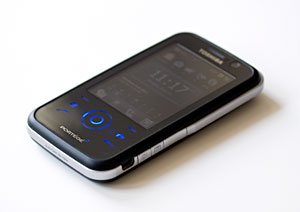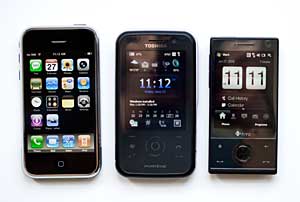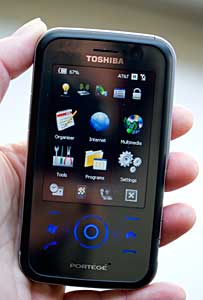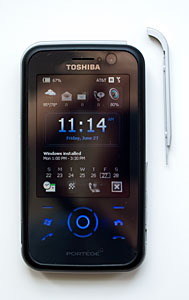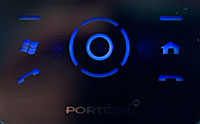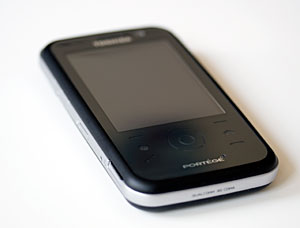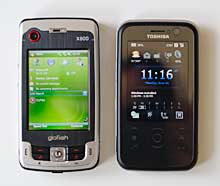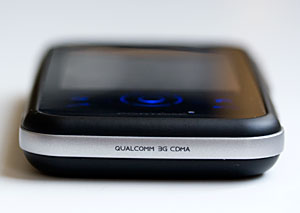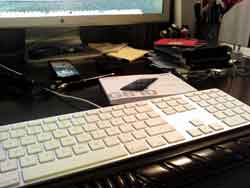
|
|||||||||||||||||
Display and Touch The phone has a 64 thousand color 2.83" touch screen that's one of the best among Windows Mobile Pro phones. It's extremely bright (retina-burning at max brightness indoors), very sharp and colorful. It comes closer to the iPhone's lovely display than any other WinMo phone to date, including the Sony Ericsson Xperia. That brightness comes in handy for outdoor viewing; unlike many WinMo Pocket PC phones, the G810's display is viewable outdoors. It does lose color saturation and some contrast but it remains readable. The screen is also pleasingly sensitive and responsive. It's more iPhone-like in terms of responsiveness and requiring a light touch than the HTC Touch products which require a great deal of pressure and a concerted finger-drag to scroll. Here's a 5 minute video of the Toshiba G810's touch interface, design and GPS: Since the VGA Diamond, Xperia and 400 x 240 (err, wide QVGA) Omnia, higher resolution displays are hot with power users and high end PDA phone buyers. The Toshiba sticks with QVGA, which won't impress your uber-geek buddies, nor will you see lots more on screen when mapping your way to a destination. We do miss VGA for Google maps, and browsing with NetFront 3.5, the only browser that maintains initial page overview readability on a tiny VGA screen. But for other uses, QVGA is easier on the eyes and easier to control with a finger (UI controls and hyperlinks aren't too small to poke with a fingernail). Opera 9.5 on the Diamond looks lovely, but the initial web page overview uses greeked text, so you've got to tap and zoom in (and scroll) to read. We like VGA, but we like it much better on large screen devices like the HTC Advantage X7510, that are suited to the resolution. Touch Controls An interesting phone sports a few controversial features. The Toshiba has two: its stylus and front buttons. Toshiba worked to integrate the stylus into the device's lines while avoiding taking up extra space for a traditional silo. They came up with a stylus that doubles as the side trim. There's a silver plastic trim ring that runs along all four sides of the phone, and that trim ring sticks out a little bit more on the upper right side. That ever so minor hump is the stylus. While we'd never call it ergonomic, it's clever enough and helpful for those who tend to leave their stylus behind (it clearly looks like something is missing when the stylus isn't in place). Given the G810's touch UI, we didn't find ourselves reaching for that stylus very often (thankfully). It's also very pointy, looking more like a dart than an input device (it hasn't scratched the screen yet, but we still worry).
The front-facing buttons that light courtesy of blue LEDs aren't mechanical buttons but rather touch-sensitive controls. There is no haptic vibration feedback here, which makes using these buttons a numbing experience. Once we turned on button sounds (a standard feature in WinMo's sound settings), we liked the buttons quite well-- all it takes is a little sound or vibration to make an interaction feel like an interaction. These buttons are dedicated to call send and end, the Windows Start menu (useful since the on-screen Start Menu icon is hidden by the touch UI), Home button that takes you back to the "now" home screen display with the time, calendar and etc (shown above), and two softkeys that work as normal Windows Mobile soft keys except in the touch UI (Spb Mobile Shell) where they scroll through the home screen tabs. The d-pad handles the usual up/down, left/right and action, and it doesn't support swirling motions or any other fancy maneuvers. It does work decently in games-- we tried it with a few flight shooters and an RPG, and it did OK, though I'd still prefer a traditional d-pad for serious flight shooter and action games.
Touch sensitive front controls. The Rest. . . There are those who hate little rubber doors over their device's ports, and those who prefer them. The Portege G810 is for those of us who hate fiddling with little covers: the USB and microSD card slot, both integrated into the trim ring, are naked. If you carry the phone in a pocket full of super-sized dust bunnies, beware. If you lack the fingernails to manipulate those rubber covers and have a clean place to carry you phone, rejoice. The SIM card slot is located under the back battery door and the speakerphone grill is on the back just below the camera lens. Volume up down keys are flush-mounted into the left side trim along with the very small and slightly inset power button. The device powers on only when you press the power button, and given the design, it seems nearly impossible that it would get turned on accidentally (it takes a bit of care to turn it on intentionally). The right side has the camera button (launches the camera application and acts as the autofocus/shutter button), voice recorder button and mini-USB port. As with HTC devices, this is a multi-function port that handles syncing, charging and acts as the stereo headset jack. The camera and voice recorder buttons require just a soft press and as a result it's easy to accidentally press them if you're left handed and hold the device with the left hand. There are flashing LEDs above the display that flash to indicate charging (red), green (slowly) for a new message, green (quickly) for a missed call and blue for Bluetooth. These are very bright; if you keep the phone on the nightstand while charging or with Bluetooth on, turn it face down to avoid a ceiling lightshow. The Touch UI, Courtesy of Spb Software House That interface comes courtesy of Spb Software, who developed the G810's UI. This is actually a bundling of Spb's Mobile Shell, Pocket Plus and full screen keyboard applications. The apps have been tweaked to run extremely fast and with great stability on the G810, and we can easily say it's got the fastest touch screen UI among TouchFLO (on the HTC Touch), TouchFLO 3D on the Diamond, Xperia and Omnia. For those who haven't used these applications, they're very similar to the original HTC TouchFLO software, but go deeper to replace more of the standard Windows Mobile UI (but not as deep as TouchFLO 3D). Yes, you could buy another Windows Mobile Professional phone and purchase these titles separately from Spb, but the added element is the flush touch screen that's very responsive to touch, and the Spb titles really do shine on the Toshiba compared to the HTC Tilt or Glofiish X800. Sadly, most users (we don't mean you, power users) don't buy and install 3rd party software, so the out of the box experience becomes very important, which stands in favor of adding these titles at the factory. Rather than attempt a touch UI, Toshiba went with Spb, who's been doing it, and doing it very well at that, for several years. You can read about the programs in detail on Spb's web site, and this isn't meant to be a review of their software. We'll cover it in brief here for those who've never used this software. Spb Mobile Shell provides the Today Screen, program launcher, photo caller ID, dialer skin, phone profiles and weather. All elements are large and finger friendly, and you can switch between these using the softkeys, by tapping on the bottom icons that represent the tabs or by swiping your finger from side to side. When in any program, you can swipe down from the title bar to bring up the Mobile Shell, and swipe down to dismiss it. Again, the UI is extremely responsive and stable.
There's only a partial version of Spb Pocket Plus here, the part that adds "smart scrolling", which allows you to scroll by dragging a finger in Internet Explorer mobile, contacts, the programs and settings groups and a few other places. Though the phone has enough RAM to reduce our usual desire to micro-mange running programs, we miss the close button=quit app feature and multiple window IE features in full Pocket Plus. Lastly there's Spb's excellent full screen keyboard that fills the screen in landscape mode, making it very easy to type with two digits and thus avoid stylus input. Though if you're a fan of WinMo's very good handwriting recognition, that option is always there (along with the traditional, tiny WinMo on-screen keyboard).
3G HSDPA is a pleasure on the G810, and it averaged 738kbit/sec. in the Dallas area as tested on DSL Reports mobile speed test. The phone ships with the standard WinMo Internet Explorer, which is a decent basic HTML web browser. We installed the latest "concept" version of NetFront 3.5 which rocks in terms of features, rendering and touch-scrolling support. As usual, Messaging (the WinMo counterpart to Outlook e-mail) is there with support for POP3, IMAP and Exchange accounts including push email with Exchange Server 2003 SP2 or newer. Courtesy of Windows Mobile 6.1 we have (finally!) threaded SMS text messaging too. Messaging handles MMS picture and video as well. Performance and Multimedia The Toshiba G810 runs on a Qualcomm MSM7200 CPU clocked at 400MHz, same as the HTC Tilt (TyTN II), HTC Touch Cruise and Touch Dual. It has 256 megs of flash ROM and 128 megs of ROM. At boot there are ~41 megs of free RAM to run programs and 108 megs of free storage after the Spb software has installed at first boot. There's an SDHC microSD card for storage expansion and we tested a Kingston and AData 4 gig card, both of which worked fine. This is one of the fastest WinMo Pro PDA phones we've used in terms of UI response, and it feels more like a feature phone in that respect. The difference was noticeable when we switched back to the Tilt and Glofiish X800.
The Glofiish X800 and Toshiba G810. For video playback benchmarking, we used our usual test file, the BMW short film "The Chosen" encoded at 308kbps, benched at 270% using Core Player Mobile with a data rate of 838 kbit/s (TCPMP doesn't play nicely with WinMo 6.1). We used the high quality setting with the Direct Draw video driver selected (that was the only one that worked correctly). That's a good figure for video playback using a non-optimized video playback driver in Core Player. There's an incompatibility between Core Player 1.2.5 + Windows Mobile 6.1 + the Qualcomm chipset graphics as of this writing . That means lesser performance because the application can't use its usual accelerated Qtv driver. Performance should improve with newer versions of Core Player. Video playback performance using Windows Media Player mobile was good with a variety of QVGA videos encoded at mobile-friendly bitrates of 550kbps or lower. Music playback quality, and the Portege supports WMA, MP3 and AAC files via Media Player Mobile. Headset volume wasn't terribly loud until we adjusted the conservatively set headset volume limited under system settings. The speaker is oddly quiet and thin when playing music, and certainly won't fill a room with sound. A2DP Bluetooth stereo sounded great and loud with the Samsung SBH500. Music was full with strong bass and subtitles came through clearly.
The FM radio proved to be another pleasant surprise, with better than average reception. On auto-find, the phone found about 35 stations in a Dallas suburb, while various Nokia and E-TEN smartphones found only a handful. The FM radio supports RDS for station and song data and can record radio broadcasts (just hit the record button) or schedule a future recording (very cool!). Like all phones, the headset functions as the radio's antenna and so much be plugged in, though you can set the radio to play though the phone's speaker instead of the headset if you wish.
GPS The G810 has an integrated GPS that's part of the Qualcomm chipset, just like the HTC TyTN II/Tilt and Touch Cruise. There's an A-GPS utility that downloads satellite data to speed fix times, but no other GPS software is included. Though not the more robust SiRF III GPS chipset found on E-TEN Glofiish phones, the G810 did well for fix times (cold fix in a minute, hot fix in 15 seconds) and accuracy. We tested it with the free Google Maps and Windows Live, both of which worked well with the GPS and we didn't have to twiddle with any settings to get it going. We also tested it with CoPilot Live 7, which found the GPS automatically and gave good routing and location information. The GPS had no trouble getting a signal in a car, outdoors or indoors within 10 feet of a window. The Toshiba's speaker is clear and spoken directions were easy to understand, though the speaker might not be loud enough for a large 4x4 truck with a noisy differential or a top-down sports car. Battery Life The phone ships with a 1530 mAh Lithium Ion battery. That's a fairly high capacity battery and the phone lasted us two days with moderate use. The first few days and charges weren't very impressive, but after 4 charge cycles the battery settled in and we got just below average battery life for a Pocket PC phone that's replete with features. It's hard to describe "average" use with a PDA phone that does so much-- WiFi, GPS, 3G and push email are all battery eaters for example and video playback uses more power than Office and PIM apps. That said, in 3G mode with 20 minutes of GPS navigation time via CoPilot 7, surfing the web for an hour total each day over HSDPA, listening to the FM radio for 30 minutes/day, checking email on a 15 minute schedule (non-push) and talking on the phone for 40 minutes daily, the G810 lasted 1.5 days. Moderate to heavy users will need to charge nightly. The phone inexplicably drained half its charge overnight (we didn't leave a bevy of apps running either) on 2 occasions. The phone supports USB charging and ships with a world charger that looks just like recent HTC and E-TEN chargers. In fact it's the same 5 volt, 1 amp output and they're interchangeable. Since the Portege is a Euro phone, it has Euro prongs so you'll need a prong adapter to plug it in (sold at Radio Shack for $5 if your vendor doesn't supply one). Conclusion Verdict? I'll keep it Pro: Great looks, light and not too large. For a gloss touch-screen phone, the screen doesn't get as mucked up with fingerprints compared to similar phones. Excellent touch screen coupled with excellent Spb touch-friendly software titles that enhance Windows Mobile's usability and fun factor. Display is very bright, sharp and colorful. The Toshiba G810 has every feature you'd expect in a high end phone, and the features work well. Good GPS, excellent camera, fast 3G HSDPA on US bands and a great FM radio. The bundled extras: Picsel Viewer, Image Editor and OCR for the camera (Image to Text) are nice additions. Con: Incoming call volume is a bit low and voice quality on both ends isn't as good as most HTC PDA phones and smartphones. Camera capture time is slow at highest resolutions. Video capture isn't nearly as impressive as still shots. Speaker isn't very loud for music playback (it's louder for most anything else though). Battery life could be better. Web site: www.toshiba-europe.com/mobile Estimated price: $550
| |||||||||||||||||
